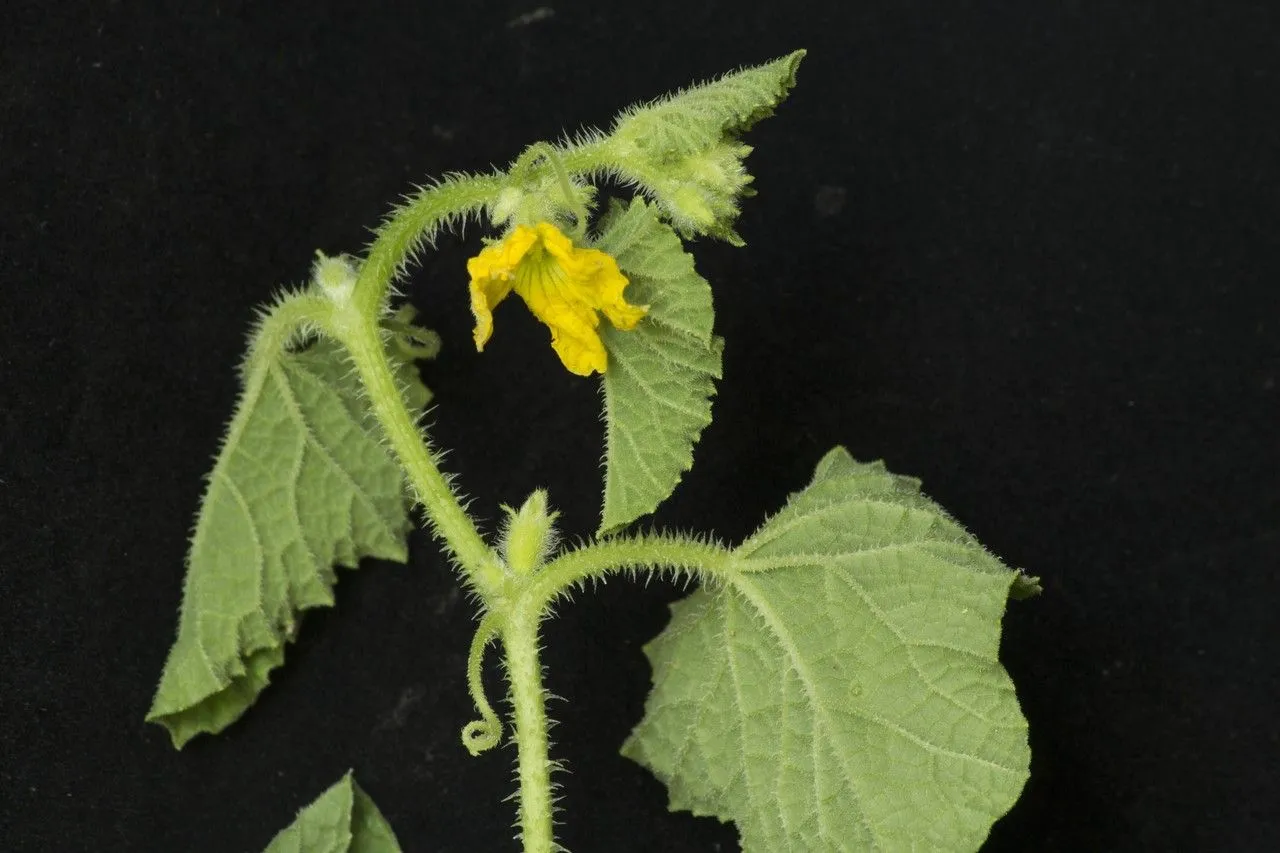
Author: L.
Bibliography: Sp. pl. 2:1011. 1753
Year: 1753
Status: accepted
Rank: species
Genus: Cucumis
Vegetable: True
Observations: Tanzania to S. Africa
The West Indian gherkin, scientifically known as Cucumis anguria and catalogued in “Species Plantarum” on page 1011 by the botanist Carl Linnaeus in 1753, is a member of the Cucurbitaceae family. This intriguing plant is widely recognized for its unique cultural and agricultural value. Native to a vast geographical expanse ranging from Tanzania to Southern Africa, the West Indian gherkin is a resilient species capable of thriving in diverse environmental conditions across this broad region.
The West Indian gherkin is a creeping vine, often forming tangled masses with its slender, sprawling stems. Its leaves are deeply lobed, showcasing a rich green hue that can provide a lush cover over the ground or climb support structures vigorously. The plant’s fruit is the most distinctive feature—spined and oval, resembling miniature watermelons or gherkins, hence the common name. These fruits are typically harvested when young and tender, known for their crisp texture and slightly tangy flavor, making them a popular addition to pickles, salads, and gourmet dishes.
Agronomically, Cucumis anguria is valued for its hardiness and relatively low cultivation requirements. It flourishes in tropical and subtropical climates, where warm temperatures and consistent moisture levels promote optimal growth. It’s not only a cultivated crop but also often found growing wild, indicative of its adaptability and resilience.
In traditional agriculture, the fruits are cherished for their ability to be stored and consumed over extended periods, providing a reliable food source. The plant’s robust nature also makes it resistant to many common pests and diseases that afflict other Cucurbitaceae members, contributing to its popularity among farmers seeking sustainable crop options.
The West Indian gherkin is more than just an agricultural asset; it holds cultural significance in the regions where it is native. It serves as a dietary staple and a botanical treasure, reflecting the rich biodiversity and agricultural heritage of Tanzania and Southern Africa.
Despite its many benefits and potential, the West Indian gherkin remains less known outside its native range. Increased awareness and cultivation of this remarkable plant could provide excellent opportunities for agricultural diversity and food security in various parts of the world, embodying the intricate relationship between plants and their environments that has fascinated botanists and horticulturists for centuries.
Eng: west indian gherkin, bur gherkin, pumpkin, chicken cucumber
Swe: anguriagurka
Por: maxixe
Spa: pepino cimarrón
En: West Indian gherkin, Bur cucumber, Bur gherkin, Burr cucumber, Gooseberry gourd, Jerusalem Cucumber, West Indian gourd, Wild spiny cucumber, Pumpkin, Chicken Cucumber, West India gherkin, West Indian Cucumber, Gherkin, Maxixe, Pepino, Wild cucumber
Ar: قثد حنظلي
Bg: Ангурия
Zh: 小刺黄瓜
Cs: Okurka angurie
Nl: Surinaamse wilde augurk
Eo: Angurio
Fi: Pikkelsikurkku
Fr: Petit cornichon, Concombre d’Amérique, Petit concombre
De: Anguria-Gurke, Angurien-Gurke, Kleine Igelgurke, Pfeffer-Gurke, Westindische Gurke
Pt: Maxixe
Pt-br: Maxixe, Maxixe-bravo, Maxixe-do-mato, Cornichão-das-antilhas, Pepino-castanha, Pepino-espinhoso
Ru: Ангурия
Es: Sandía de ratón, Pepino cimarrón, Pepinillo, Pepineto, Cocombro, Pepinillo silvestre
Sv: Anguriagurka
: West indian gherkin
© copyright of the Board of Trustees of the Royal Botanic Gardens, Kew.
© copyright of the Board of Trustees of the Royal Botanic Gardens, Kew.
© copyright of the Board of Trustees of the Royal Botanic Gardens, Kew.
Taken Oct 2, 2021 by Sandra Dijou (cc-by-sa)
Taken Dec 24, 2021 by Jean Marie Bouyer (cc-by-sa)
Taken Jan 2, 2020 by Françoise AFFLATET (cc-by-sa)
Taken Jan 5, 2019 by Maudeline Chérilus (cc-by-sa)
Taken Jun 1, 2019 by Eliane C. (cc-by-sa)
Taken Jan 5, 2021 by mindseed (cc-by-sa)
Taken Nov 20, 2020 by Merighe Luana (cc-by-sa)
Taken Jul 16, 2020 by dos santos Willian bentes (cc-by-sa)
Taken Mar 5, 2021 by aquino denison (cc-by-sa)
Taken Jul 16, 2020 by dos santos Willian bentes (cc-by-sa)
Taken Jun 4, 2020 by Mari Na (cc-by-sa)
Taken Dec 25, 2020 by Jhansisri uttaravall (cc-by-sa)
Taken Oct 26, 2019 by Aristide ZOUNGRANA (cc-by-sa)
Taken Jul 4, 2020 by Tryphon Papy (cc-by-sa)
Taken Jan 1, 1900 by EOL − Bart Wursten (cc-by-nc)
Taken Sep 5, 2022 by Pallino (cc-by-sa)
Taken Feb 15, 2017 by Photoflora – Benoit BOCK (©)
Taken Feb 15, 2017 by Photoflora – Benoit BOCK (©)
Taken Sep 15, 2006 by Photoflora – Jean-Luc TASSET (©)
Taken May 8, 2022 by Eduardo Vaz (cc-by-sa)
Taken Jan 1, 1900 by EOL − Bart Wursten (cc-by-nc)
Taken Jan 1, 1900 by EOL − Gibran Morales C. (cc-by-nc-sa)
Taken Jan 1, 1900 by EOL − Carrington, S. (cc-by-nc-sa)
Taken Jan 1, 1900 by EOL − Gibran Morales C. (cc-by-nc-sa)
Taken Jan 1, 1900 by EOL − Bart Wursten (cc-by-nc)
Taken Jan 1, 1900 by EOL − Bart Wursten (cc-by-nc)
Growth habit>: Vine, Forb/herb
Family: Myrtaceae Author: (F.Muell.) K.D.Hill & L.A.S.Johnson Bibliography: Telopea 6: 402 (1995) Year: 1995 Status:…
Family: Rubiaceae Author: Pierre ex A.Froehner Bibliography: Notizbl. Bot. Gart. Berlin-Dahlem 1: 237 (1897) Year:…
Family: Sapindaceae Author: Koidz. Bibliography: J. Coll. Sci. Imp. Univ. Tokyo 32(1): 38 (1911) Year:…
Family: Asteraceae Author: A.Gray Bibliography: Pacif. Railr. Rep.: 107 (1857) Year: 1857 Status: accepted Rank:…
Family: Fabaceae Author: Medik. Bibliography: Vorles. Churpfälz. Phys.-Ökon. Ges. 2: 398 (1787) Year: 1787 Status:…
Family: Aspleniaceae Author: (Cav.) Alston Bibliography: Bull. Misc. Inform. Kew 1932: 309 (1932) Year: 1932…